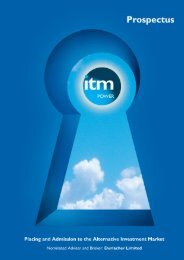cell - ITM Power
cell - ITM Power
cell - ITM Power
- No tags were found...
You also want an ePaper? Increase the reach of your titles
YUMPU automatically turns print PDFs into web optimized ePapers that Google loves.
feature<strong>ITM</strong>’s membrane technologyunlocks the power of hydrogenBy Dr Simon Bourne – Chief Technology Officer, <strong>ITM</strong> <strong>Power</strong> Plc, UK<strong>ITM</strong> <strong>Power</strong> is best known for its hydrogen fuelling technology, but thetechnology behind its electrolyser systems can also be utilised in fuel <strong>cell</strong>s.This article looks at how the company’s hydrocarbon membranes can offerdistinct advantages in applications such as fuel <strong>cell</strong> electric vehicles.When most commentators write about <strong>ITM</strong><strong>Power</strong> they focus on energy storage, clean fuelproduction, and the company’s packaged CEmarked refuelling technology. Very little hasbeen written about the <strong>ITM</strong> <strong>Power</strong> fuel <strong>cell</strong>MEA – mainly because the technology hasbeen developed in ‘stealth’ mode. Patentedworldwide, the technology is now being testedby many major players in the hydrogen energyindustry.<strong>ITM</strong> <strong>Power</strong> is a UK company making businessout of hydrogen [see the feature on its hydrogenfuelling technology in FCB, January 2012]. Havingdesigned, operated and sold fully integratedhydrogen refuelling systems, the company hasmade a name for itself as a provider of cleanfuel. <strong>ITM</strong> has a few things to say about fuel<strong>cell</strong>s too, having spent several years developinga unique membrane technology that offers starkdifferentiation from the competition.While the company has no plans tocommercialise a packaged fuel <strong>cell</strong> productitself, <strong>ITM</strong> does intend to make its fuel <strong>cell</strong>membrane available for integration within keypartnerships – and there are a few good reasonswhy some big companies may be consideringjust that...The heart of the systemBuried deep inside <strong>ITM</strong>’s hydrogen generationsystems is a series of electrolyser stacks. Each ofthese contains a number of membranes – solidpolymer electrolyte in the form of a thin film.The membranes have catalyst on both sides,and play a crucial role in the electrochemicalprocess of hydrogen creation from water by(among other things) allowing conduction ofprotons. The same function also enables themembrane to be used in a fuel <strong>cell</strong>, this timeconsuming hydrogen to generate power.The fuel <strong>cell</strong>Fuel <strong>cell</strong>s convert fuel in the form of hydrogenand oxygen into electricity and water. Theyhave no moving parts, release no harmfulemissions, and can operate at high efficiency.Taken together, the positive attributes of fuel<strong>cell</strong>s offer several advantages over batteries andconventional engines. Individual <strong>cell</strong>s havea low voltage with the capacity to generatea high current. Therefore, it is common formultiple <strong>cell</strong>s to be arranged in electrical seriesinto stacks.Figure 1. A Hyundai ix35 FCEV fuel <strong>cell</strong> electric vehicle is refuelled by an <strong>ITM</strong> <strong>Power</strong> HFuel hydrogenstation that generates ‘green’ hydrogen onsite, at the All-Energy 2012 show in Aberdeen, UK.ApplicationWhile fuel <strong>cell</strong>s are gaining traction in severalapplication areas, deployment in the nextgeneration of vehicles is probably the most wellknown.Hyundai is leading the charge among theautomotive OEMs with deployment of fuel<strong>cell</strong> electric vehicles planned for 2013, followedby Daimler in 2014, and then just about everyother manufacturer in 2015 (Figure 1). Thereare indeed several coordinated national schemesaddressing the rollout of both FCEVs and theassociated hydrogen infrastructure. The Britishscheme, called UKH 2 Mobility, sees a joining offorces between three government departments(Energy & Climate Change, Business Innovation& Skills, and Transport) with industrialparticipants from the utility, gas, infrastructure,and global car manufacturing sectors.So fuel <strong>cell</strong> components have now beenselected and qualified for this first trancheof FCEVs. However, the fuel <strong>cell</strong> stack isacknowledged as being the single most expensivecomponent on board the vehicles, and the searchis on for the next generation of components thatwill achieve the aggressive cost reduction profiledemanded by the automotive sector.The ideal fuel <strong>cell</strong>membraneThere is no question that fuel <strong>cell</strong>s have a lotgoing for them. It would be unfair not to admitthat they have a few challenges too – the chiefamong them being cost.It is widely accepted that power density is thesingle most important parameter in reducing fuel<strong>cell</strong> cost. The more power that can be squeezedout of a fuel <strong>cell</strong>, the less fuel <strong>cell</strong> you need,offering a prime route to reduce cost throughminiaturisation. The catalysts used to promotethe forward reaction tend to be precious metalssuch as platinum. There is a fair amount ofplatinum in a conventional car exhaust system,so this is not a financial disaster, but clearly thereis a need to use as little as possible.In addition to the stack, fuel <strong>cell</strong> systems carryaround other kit, collectively referred to as thebalance-of-plant. This is a collection of valves,blowers, pumps etc. with the job of ensuringthat the fuel <strong>cell</strong> stack is provided with the right12Fuel Cells Bulletin July 2012
featureflow of reactants, maintained at the correcttemperature, and generally kept happy. While afairly crude measure, it stands to reason that adelicate stack (and the membrane in particular)demands more looking after, and hence morebalance-of-plant. Some might argue that we havegot used to carrying a lot of balance-of-plant,and therefore have cost saving opportunities heretoo, through the development of less sensitivestacks and membranes.On top of all of this, the stack needs to bedurable in the face of the demanding duty cyclesassociated with automotive applications – rapidchanges in power output, varying ambientconditions, cold starts, and all the other thingswe have grown to expect from our cars.organisation responsible for the rollout ofhydrogen infrastructure in Germany – onthe fuel <strong>cell</strong> supply chain. [1] There were threemain conclusions. The first was that increasingpower density is a prerequisite to reducingthe cost of fuel <strong>cell</strong>s (we know this already).The second was that there is consensus in theautomotive industry that 1 W/cm 2 (1.5 A/cm 2at 670 mV) is an aspirational power densitytarget (this is an extremely useful benchmark).The third conclusion was that the supply chainfor membrane-electrode assemblies (MEAs) –i.e. the membrane plus the catalyst electrodestructures – was unable to reliably supplyagainst the 1 W/cm 2 power density target.Figure 2. <strong>ITM</strong> <strong>Power</strong>’s membrane is based onhydrocarbons, which are an order of magnitudelower in cost and easier to handle than fluorocarbons.Bridging the gapIn order to describe how <strong>ITM</strong> is bridgingthe gap, we need to delve a little deeper intothe technology. Conventional solid polymermembranes are based on fluorocarbons. Theyhave very long polymer chains in an entanglementnetwork – a bit like a bowl of spaghetti. Attachedto the spaghetti are a series of shorter, pendantside-chains holding on to sulfonic acid groups. Itis these groups that render the material ionicallyconductive (when hydrated in water).<strong>ITM</strong>’s material is quite different (Figure 2).It is based on hydrocarbons, which are an orderof magnitude lower in cost and easier to handlethan fluorocarbons. Furthermore, the polymeris crosslinked, giving it defined structure inthree dimensions and important mechanicalcharacteristics. It is possible for the materialto be rendered acidic or alkaline, providinganother level of flexibility not possible tocapture in this article.They key thing here is that <strong>ITM</strong>’s material isin fact a suite of materials. By varying the ratioof the four main components in the formulation,the ultimate material properties may be variedover a very wide range.While it is obvious to strive for an optimumwhere all key properties are simultaneouslymaximised, unfortunately the real worlddoesn’t usually allow for that, forcing sometough trade-offs. This is where <strong>ITM</strong>’s materialand formulation experience comes into itsown – providing a unique ability to modifythe formula to effectively pick and choosethe properties that make the biggest impact(Figure 3). This is an area where <strong>ITM</strong> hasconcentrated some serious effort, and thebenefits are becoming very clear indeed.<strong>Power</strong> densityIn early 2011, André Martin and LudwigJörissen reported for NOW GmbH – theFigure 3. <strong>ITM</strong> <strong>Power</strong>’s membrane offers a unique ability to modify the formula to effectively pick andchoose the properties that make the biggest impact.Figure 4. The achievement of power densities above 5.5 W/cm 2 at over 10.5 A/cm 2 (hydrogen andoxygen) shows that the <strong>ITM</strong> membrane has something special to offer.July 2012Fuel Cells Bulletin13
featurethe 1 W/cm 2 target shared among theautomotive community was exceeded.Catalyst loadingFigure 5. Fuel <strong>cell</strong>s will always show reduced power density when using air rather than pure oxygen,yet the <strong>ITM</strong> membrane clearly demonstrates a relatively high power density.When <strong>ITM</strong> first began investigating itsmaterials for use in fuel <strong>cell</strong>s, hydrogen andpure oxygen were used. This was a logicalchoice as the company generates both gasesfrom its electrolyser systems, and there is meritin understanding how the two interface withone another.The achievement of power densities inexcess of 5.5 W/cm 2 at over 10.5 A/cm 2 wasevidence that the <strong>ITM</strong> membrane materialhas something special to offer (Figure 4). Thisis believed to be the highest ever reportedpower density from any fuel <strong>cell</strong>, and by somedistance. While the company’s focus has been(and still is) on electrolysis, the ultra highpower density performance justified furtherdevelopment effort. Benchmarking againstconventional membrane materials showed theionic resistance of <strong>ITM</strong>’s material to be anorder of magnitude lower than the incumbentmembrane technology.In 2011, <strong>ITM</strong> benefitted from somefunding from The Carbon Trust to explore thechemical stability of the membrane, and toestablish if the unusually high power densitycould be achieved using hydrogen and air(rather than oxygen) – and also at significantlylower catalyst loadings. While there willalways be a reduction in power density whenmoving from pure oxygen to air (owing todilution of the oxidant with nitrogen), thehigh power density characteristic of the<strong>ITM</strong> membrane material was clearlydemonstrated (Figure 5). It is notable thatFigure 6. <strong>ITM</strong> has achieved an 85% reduction in catalyst loading while maintaining 90% of thepower density.So, high power density – that box is ticked.However, that is of limited benefit if thecost saving is countered by high loadings ofexpensive catalyst materials. <strong>ITM</strong> began itsfuel <strong>cell</strong> research using platinum black (thestandard catalyst), and at high loading. Thiswas deliberate to ensure it was the membraneitself that was interrogated rather than thecatalyst membrane composite.Simply reducing the platinum black loadingresulted in a predictable loss in power density.However, shifting to supported platinumcatalysts showed a dramatic increase inperformance at lower loadings. Adding a smallamount of ionomer coating to the catalystsdemonstrated further performance benefits. Assuch, <strong>ITM</strong> has achieved an 85% reduction incatalyst loading while maintaining 90% of thepower density (Figure 6). There is more work tobe done in this area, but this is not a bad start.Couple this with <strong>ITM</strong>’s ability to deliver verylow catalyst loadings via its patented one-stepmembrane fabrication route, and we can seethat the technology has a lot to offer.SensitivityHigh power density – tick. Low catalyst loadingcapability – tick. But what about the need tocarry a lot of balance-of-plant?An important factor here is the hydraulicstability of the membrane. This relates to themechanism of ionic conduction within themembrane which requires water to surroundthe acid sites. Should the membrane dryslightly under operating conditions, the abilityto conduct protons will diminish, reducing theperformance of the fuel <strong>cell</strong>. To combat this, itis common for fuel <strong>cell</strong> systems to incorporatehumidification plant, essentially adding waterto the input gas streams in order to protectagainst membrane dehydration.The <strong>ITM</strong> material has another trick upits sleeve here, having a hydrophilic (waterattracting) moiety tied into the polymerstructure. This extra ingredient helps themembrane material hold on to water andminimise the need for hydration balance-ofplant.Elimination of fuel <strong>cell</strong> subsystems isa good thing! All of the power density datapresented in this article were collected usingunhumidified feed gases.In situ analysis of membrane conductivityas a function of relative humidity has shown,firstly, that the <strong>ITM</strong> class of materials hassignificantly higher ionic conductivity; and14Fuel Cells Bulletin July 2012
featuresecondly, that even at low humidity levels,its conductivity still exceeds that of theincumbent materials (Figure 7).Cost structureThere is always great difficulty in translatingsignificant advances achieved in the laboratoryto genuine impact in the commercial world.The same is true here. However, there are toolsavailable to take on this challenge.The Carbon Trust commissioned anindependent techno-economic analysis toquantify the cost benefits of <strong>ITM</strong> <strong>Power</strong>’smembrane technology compared to the currentstate-of-the-art. [2] The analysis – which isexpected to be published in due course –utilised the TIAX modelling architectureoriginally developed with and used by the USDepartment of Energy to project costs of neartermfuel <strong>cell</strong> technology at high productionrates (Figure 8). Early indications from thetechno-economic analysis suggest that fuel<strong>cell</strong> technology using <strong>ITM</strong> <strong>Power</strong>’s membraneand low catalyst loadings could be capableof achieving US$35/kW in manufacturingquantities of 500 000 units per annum,although confirmation will have to wait for thefinal report. This is particularly relevant, as theanalysis identifies the point at which fuel <strong>cell</strong>electric vehicles become cost-competitive withinternal combustion engines is at $36/kW.A base case projecting the cost ofincumbent fuel <strong>cell</strong> technology under thesame conditions, showed a cost of $49/kW.Reducing this cost to $36/kW was shownto be capable of increasing the market shareof FCEVs by 10% (160 million vehicles) by2050, equating to an additional $25 billionof PEM fuel <strong>cell</strong> market value.Figure 7. The <strong>ITM</strong> membrane has a hydrophilic moiety tied into the polymer structure, which helpsthe material hold on to water and minimise the need for hydration balance-of-plant.About <strong>ITM</strong> <strong>Power</strong><strong>ITM</strong> <strong>Power</strong> designs and manufactureshydrogen energy systems for energy storageand clean fuel production. The company hasgrown from its original platform of novelpolymeric electrolytes (for water electrolysisand hydrogen fuel <strong>cell</strong>s) to that of atechnology provider. It now has both a strongbase of intellectual property and engineeringexpertise for providing complete hydrogensolutions and CE marked products for sale.<strong>ITM</strong> <strong>Power</strong> Plc was admitted to theAlternative Investment Market (AIM) of theLondon Stock Exchange in 2004, and raisedinitial funding of £10 million (US$15.5million) in its Initial Public Offering. Afurther funding round of £28.5 million ($44.1million) was completed in 2006. The companyhas now made the transition from a researchFigure 8. A techno-economic analysis commissioned by The Carbon Trust quantifies the potential costbenefits of <strong>ITM</strong>’s membrane technology compared to the current state-of-the-art.and development company to a productmanufacturer and technology provider. Astrong set of results in 2012 shows a growingcustomer base and associated product revenue.References1. André Martin and Ludwig Jörissen: Auto-Stack – Implementing a European automotivestack cluster. 2nd International Workshop onDegradation Issues in Fuel Cells, Thessaloniki,Greece. Available at http://tinyurl.com/ce65sn92. The Carbon Trust: <strong>ITM</strong> <strong>Power</strong> – <strong>Power</strong>ingup for the next generation of hydrogen cars.Web: www.carbontrust.com/our-clients/i/itmpowerFor more information, contact: Dr Simon Bourne,<strong>ITM</strong> <strong>Power</strong> Plc, 22 Atlas Way, Sheffield S4 7QQ, UK.Tel: +44 114 244 5111,Email: sjb@itm-power.com,Web: www.itm-power.comJuly 2012Fuel Cells Bulletin15









